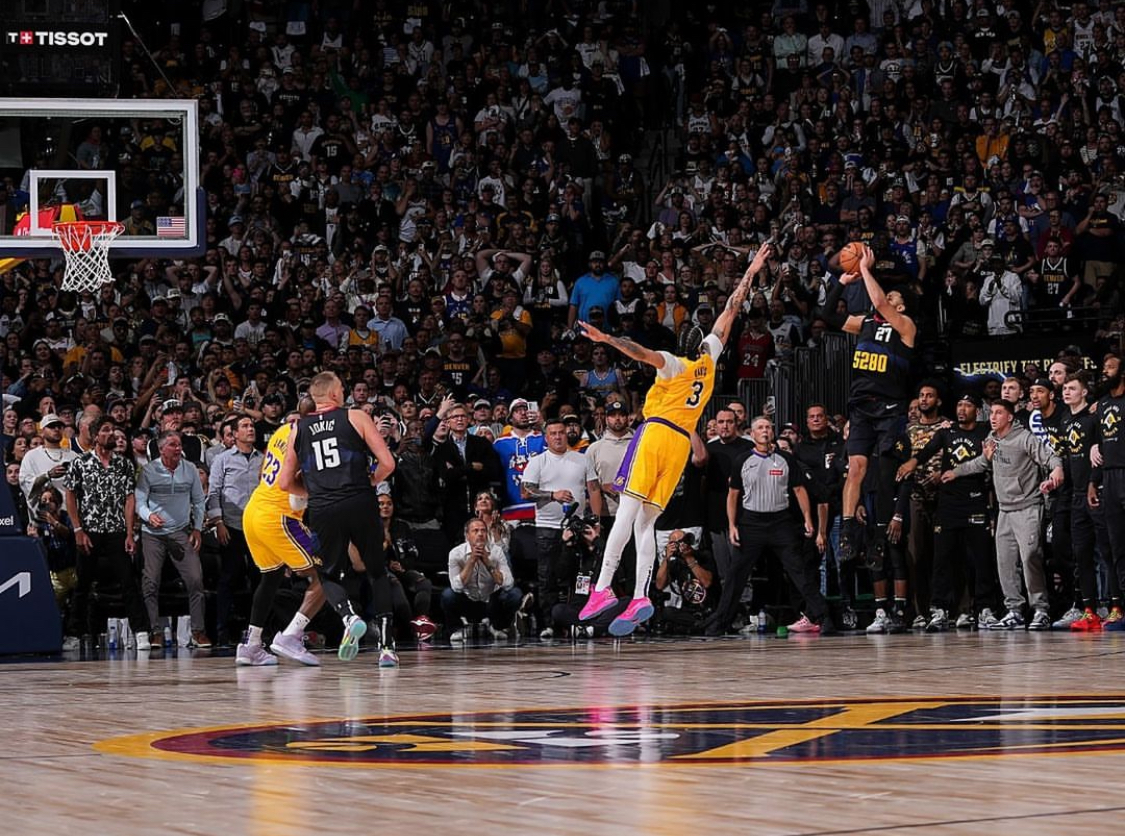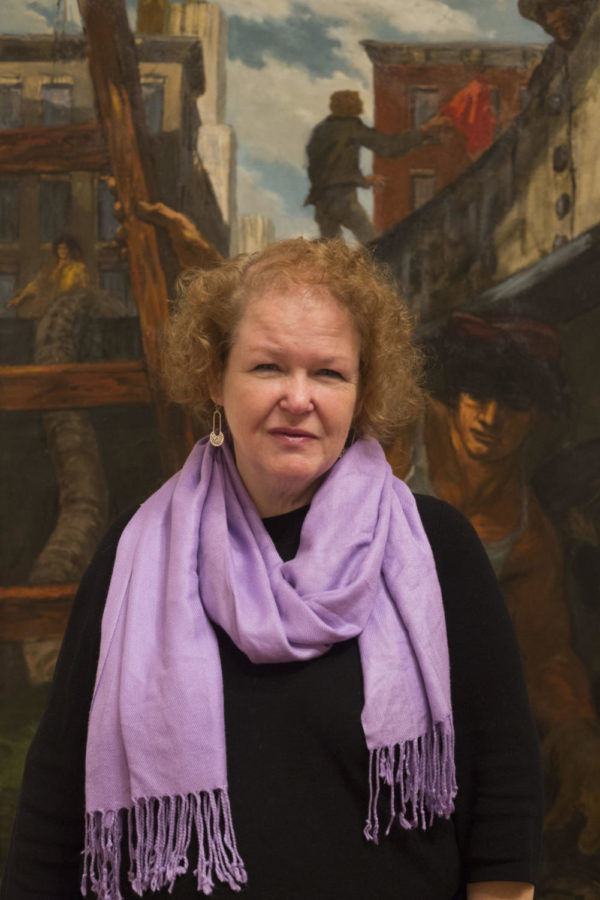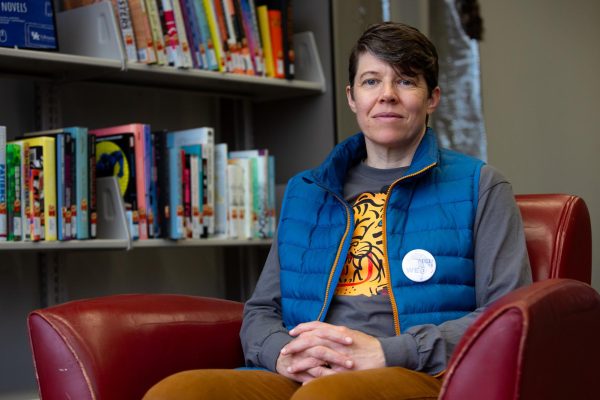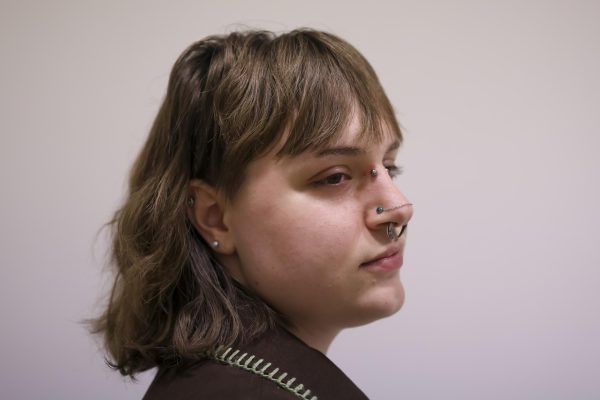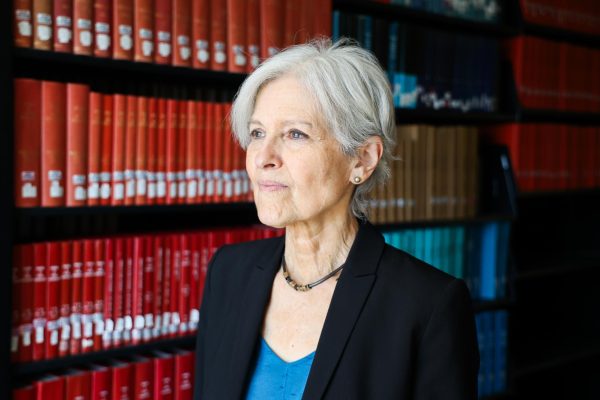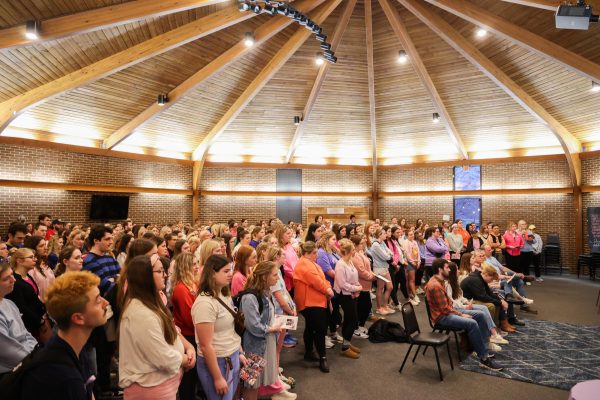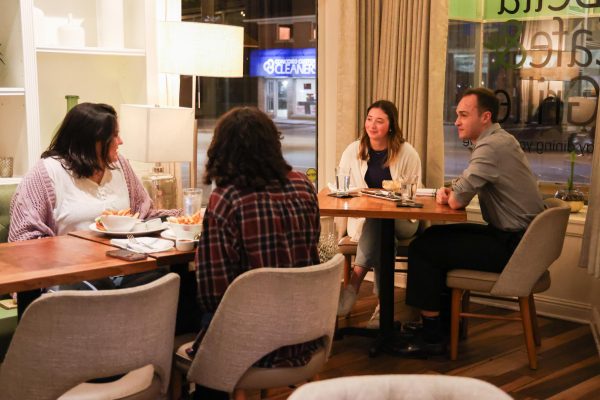Linking past and present: The UK Art Museum
Janie Welker, curator of the UK Art Museum, poses with Edward Melcarth’s painting ‘Excavation.’ UK Art Museum’s Edward Melcarth: Points of View is on display until April 8.
February 20, 2018
It’s a Thursday morning and Janie Welker, curator of the UK Art Museum, is staring at the floors. Each block in the 70s-era floors of the museum was placed individually, carefully taking into account the grain pattern of the wood so that every few blocks are mirror images of each other.
Just a few minutes earlier, she and the museum’s preparator, Alan Rideout, were poring over the frames – even more than the artwork – of Water Ways, the new exhibition upstairs curated from the museum’s permanent collection. Part textbook and part dignitary, Welker can talk about anything.
With as much thought and precision as the men who meticulously installed the museum’s floors 40 years ago, Welker has planned the museum’s exhibitions for the past 13 years. Her anniversary at the museum was in January.
“There’s no typical day,” Welker said. She’s right.
It seems now, more than ever, the museum, the community and the country are recognizing the immense change in our perceptions of gender and power. With three gender-related shows – Modern Women, Looking at Men and Edward Melcarth: Points of View – currently on display, it’s clear that Welker and the museum aren’t letting the history and value of these discussions go unnoticed.
“As a museum, we are setting ourselves up as a center for discussion for a lot of ideas and for museums to stay relevant, they need to do that,” Welker said. “It’s important to have artists who are engaging and ideas that not everybody might be comfortable with, not just for the sake of being provocative but for the sake of connecting with what’s going on in the world.”
“Provocative” is a good word to use for the museum’s current downstairs exhibition, Edward Melcarth: Points of View. Melcarth, a Louisville-born artist of Jewish descent, a gay man and a Communist investigated by the FBI, “hit the trifecta of unpopularity in the 1950s,” as Welker likes to say.
Despite being one of Life magazine’s artists to watch, Melcarth was largely undiscovered in Kentucky until Jonathan Coleman of the Faulkner-Morgan Pagan Babies Archive brought the museum’s attention to the controversial pieces acquired by the Forbes collection after Melcarth’s death.
“Timely” is another good word to use, as Melcarth’s hyper masculine and often homoerotic subject matter offers an eerily reflective view of today’s society.
“We have an opioid crisis in the country and really in Kentucky,” Welker said. “He was very keyed into drug culture at the time and in many ways aestheticized that, painting these beautiful young junkies and beautiful young men, again referencing gay culture.”
With every inch of wall space, with every word on each placard, Welker and her team are deliberate – and it pays off. At the January opening of Points of View, Welker beamed with satisfaction as the community rejoiced.
Robert Morgan of the Faulkner-Morgan Pagan Babies Archive was particularly moved by the museum’s enthusiasm for the show, as Kentucky isn’t typically the first place that comes to mind in matters of tolerance and acceptance.
“We’re talking about a community that just took down Confederate statues,” he said. “Celebrating a homosexual artist at a museum in the center of Kentucky is a big deal.”
Next door to Melcarth’s work is another new exhibition from the museum’s permanent collection, Looking at Men, “which is really key to what’s going on as Al Franken just resigned,” Welker said.
“We think a lot about what’s going on in the world,” she said. “Since Stuart [Horodner], our current director, has been here, we’ve really been trying to relate to current events in a timelier fashion and to think about some of the issues that have been raised.”
Before Welker was the methodical curator she is today, she was a methodical journalist. She worked for 12 years as a newspaper reporter, eight of which were in Easton, Pennsylvania as the arts and entertainment editor for the Express Times.
Welker made the transition from journalist to curator gradually, writing more and more about art openings in New York City.
“The openings are generally on days that the museums are closed,” she said. “So I would be at the Metropolitan Museum and be able to spend the whole day looking at a Velázquez exhibit or a David Hockney exhibit or a Goya exhibition or a Degas exhibition and it was really like an art history education.”
Welker took her two-week vacation one day at a time to take a class in contemporary art in the city.
“I wanted to deal with art on a more intimate level and to be able to understand it in more depth,” she said. “So one day a week I’d take off and I’d go to all these galleries and go to the class and then afterwards go to even more galleries.”
After earning a Master’s in modern and contemporary art history and critical theory at SUNY-Stony Brook, Welker struggled to find a full-time curating job. She mentioned that in journalism, she never went for a job interview without being offered a job, which was not the case in the art world. Now, however, journalists are often faced with the same reality.
“At the time that I left journalism to pursue a career in art history, people thought I was nuts. My family really thought I was nuts,” Welker said. “But now so many of my colleagues in journalism have lost their jobs and are seeking other kinds of careers. It’s a changing world.”
After working part-time and freelance jobs in Brooklyn, Welker finally landed at the Heckscher Museum in Long Island. From there, she came to Kentucky.
When Breach, the fall exhibition by Alison Saar, first arrived at the museum, Welker had a full-circle moment as the exhibition journeyed to UK from a college gallery in Easton, Pennsylvania, where she worked as a journalist. Saar’s work was important to the museum not just because of Welker’s personal connection, but also because of her efforts to diversify the museum’s collection.
“We need to add strong, female artists of the 20th and 21st century and works by people of color and non-western artists,” she said. “Alison Saar is someone whose work I just happen to love and who is addressing themes related to African American culture with Greek mythology and classical sculpture. If there’s anything that typifies 21st century art, it’s that globalization and that diversity.”
The museum purchased one of Saar’s pieces for the permanent collection, which is a rarity despite the museum’s nearly 5,000 pieces. For each piece, Welker’s passion is unmatched.
In December, Welker ran into a woman exploring the collection upstairs. They started chatting – as Welker can do with anyone, about anything – and the woman revealed that she was an engineering student escaping the “numbers mindset.”
Welker, as could be expected, is a firm supporter of the escape, appreciation and meditation that a piece of art in a museum can offer.
“Art just takes you out of yourself,” Welker said. “It gets you out of your everyday mind and everyday thinking. It’s important to remember those cultural values that go back thousands of years and yet, everything old is new again so the times may have changed and the specifics may have changed but a lot of the issues remain.”
Modern Women, Looking at Men, and Edward Melcarth: Points of View will be on display at the Art Museum through April 8, 2018. Water Ways will be on view through July 22, 2018. Admission to the museum is free.






































